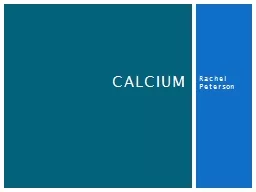

Calcium Osteoporosis the deficiency disease of calcium has been discovered in 4000 year old Egyptian mummies Determined by presence of dowagers hump or curved spine Used to create plaster of Paris 1000 years ago to set broken bones ID: 270607
Download Presentation The PPT/PDF document "Rachel Peterson" is the property of its rightful owner. Permission is granted to download and print the materials on this web site for personal, non-commercial use only, and to display it on your personal computer provided you do not modify the materials and that you retain all copyright notices contained in the materials. By downloading content from our website, you accept the terms of this agreement.
Slide1
Rachel Peterson
Calcium Slide2
Osteoporosis, the deficiency disease of calcium, has been discovered in 4000 year old Egyptian mummies
Determined by presence of dowager’s hump or curved spine
Used to create plaster of Paris 1000 years ago to set broken bones
HistorySlide3
Leafy greens: collards, kale, broccoli, turnip greens
Fortified foods: breakfast cereals and fruit juices
Dairy Products: milk, yogurt, cheeseCrackers, white bread, rollsSalmon and sardines
Calcium in FoodsSlide4Slide5
RDA for Adults 19-50 years
1000 mg/day
RDA after women are 50 and men are 701200 mg/dayAdolescents
1300 mg/dayDaily Value1000 mg/day
Calcium needsSlide6
Occurs along length of intestinal tract
A
bsorbed most efficiently in upper region of small intestineAbsorption decreases at end of small intestine and colon
Some is absorbed via passive diffusion
absorptionSlide7
Our bodies are able to absorb greater amounts of calcium during periods of growth
Infancy
PregnancyVitamin D promotes calcium absorptionAdults absorb 25-30%
Reduced absorptionSecretion of stomach acidChronic diarrhea
Intake of phytic acid, oxalic acid, phosphorus, polyphenols
absorptionSlide8
Calcium is transported in two forms
Free ionized form
Protein-bound form99% of calcium is stored in bones and teeth
Calcium is excreted via urine and sweat
Transport and storageSlide9
Low calcium levels:
Parathyroid hormone (PTH) released
PTH works with vitamin D to increase kidney’s reabsorption of calciumKidneys inhibit calcium from being excreted in urinePTH promotes synthesis of vitamin D and helps calcium be released from bones
High calcium levels:Less PTH is released
Urinary calcium excretion increases
Vitamin D synthesis decreases
Calcitonin is released to block calcium loss from bones
Calcium in the bloodstreamSlide10
Bone development and maintenance
Blood clotting
Transmission of nerve impulsesMuscle contractionCell metabolismControlling blood pressure
FunctionsSlide11
UL: 2500 mg/day for adults aging 19-50
UL: 2000 mg/day for adults 50+
Typically caused by supplementationHypercalcemiaHigh concentration of calcium in blood
Kidney stone developmentKidney failureIrritability and headache
Decreased absorption of other minerals
Upper level of calciumSlide12
Osteopenia
Osteoporosis
Affects 8 million women and 2 million men in USMore prevalent in Caucasian/whites and postmenopausal women
KyphosisPrevention: early intake of calcium and vitamin D, intake of other minerals, exercise/weight training
Calcium deficiencySlide13
KyphosisSlide14
osteoporosisSlide15
45% of adults report using
Contain salts like calcium carbonate or calcium citrate
May contain vitamin D to increase absorptionShould be used with cautionHypercalcemia
Calcium deposits Interactions with other minerals
Lead contamination
supplementationSlide16
Relationship between calcium supplementation and cardiovascular events
Found that supplementation had varied effects on cardiovascular events, stroke, and myocardial infarction
Concluded that the benefits of a calcium supplement outweigh the risk of cardiovascular events
Current researchSlide17
Relationship between protein intake, calcium balance, and the health consequences
Researchers hypothesized that a high protein intake would exert a hypercalciuric effect and a low urinary pH
Effects together promote skeletal demineralizationFound that high protein diets do induce an increase in urinary calcium excretion, but are not linked to an impaired calcium balance or decrease in bone density
Current researchSlide18
Unable to access the Evidence Analysis Library
EALSlide19
What are sources of calcium?
What is the RDA for calcium?
What two hormones are used in maintaining blood calcium levels?What is the deficiency disease associated with calcium?
QuestionsSlide20
Byrd-Bredbenner, G. Moe, D. Beshgetoor, & J. Berning, Wardlaw's Perspectives in Nutrition-Ninth Edition (pp. 512-523). New York, NY: The McGraw-Hill Companies. (2013)
Calvez, J., Poupin, N., Chesneau, C., Lassale, C., & Tome, D. (2012). Protein Intake, Calcium Balance, and Health Consequences. European Journal of Clinical Nutrition, 281-295.
Dietary Supplement Fact Sheet: Calcium. (2013, March). Retrieved October 27, 2013, from Office of Dietary Supplements: National Institutes of Health: http://ods.od.nih.gov/factsheets/Calcium-HealthProfessional/#h10
Downing, L., & Islam, M. A. (2013). Influence of Calcium Supplements on the Occurance of Cardiovascular Events. American Journal of Health-System Pharmacy, 1132-1139.
Hacker, A. N., Fung, E. B., & King, J. C. (2012). Role of Calcium during Pregnancy: Maternal and Fetal Needs. Nutrition Reviews, 397-409.
Peters, B., Verly Jr., E., Marchioni, D., Fisberg, M., & Martini, L. (2011). The Influence of Breakfast and Dairy Products on Dietary calcium and Vitamin D Intake in Postpubertal Adolescents and Young Adults. Journal of Human Nutrition and Dietetics, 69-74.
Sizer, & Whitney, Nutrition: Concepts & Controversies (pp. 288-290). Belmont, CA: Wadsworth Cengage Learning. (2011)
Spangler, M., Bryles-Phillips, B., Ross, M. B., & Moores, K. G. (2011). Calcium Supplementation in Postmenopausal Women to Reduce Risk of Osteoporotic Fractures. American Journal of Health-System Pharmacy, 309-318.
Bibliography